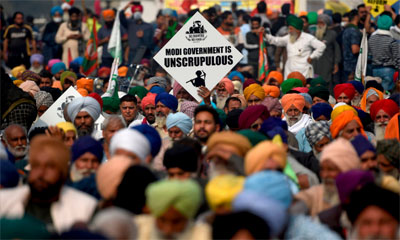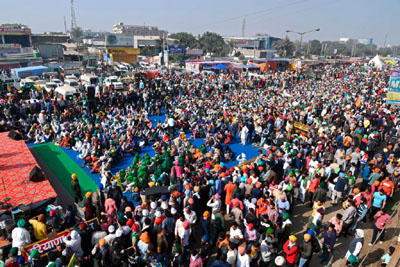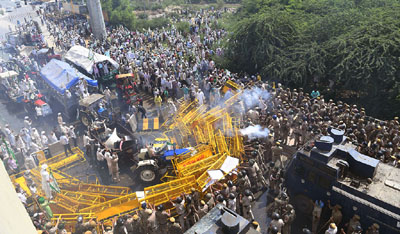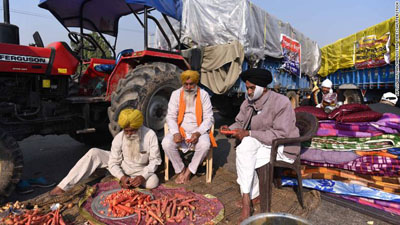|
Yeh Inquilab Hai, Sir:
Indian Farmers and the Architecture of Protest
Vinay Lal
Almost to the day, one year ago, the Dadis (or grandmothers) of Shaheen Bagh stood up to the Indian state while most of the Indian middle class, which capitulated to the Modi government when it first assumed power in 2014, looked on silently as one of the most remarkable nonviolent protests anywhere in the world was carried out with discipline over several months before the pandemic took over the lives of everyone and furnished the state with the pretext to send the Dadis back to their homes. Now, with the rebellion of the farmers, a new front has been opened in the battle of the country’s ordinary citizens against a wholly authoritarian government that is frighteningly intolerant of dissent and reeks of the arrogance of power. “Power tends to corrupts”, the English politician and writer Lord Acton famously declared, “and absolute power corrupts absolutely.”

Farmers gathered in protest at the Delhi-Haryana border at Singhu on 4 December 2020. Photograph: Agence France-Presse.
The farmers of Punjab and Haryana, and increasingly of the rest of India, have taken to the streets and rattled the government—if ever so slightly. The Shaheen Bagh protestors were pilloried as anti-national: since many were Muslim women, it was all too easy to paint them, and their supporters—students, liberals, human rights activists, and sometimes just people committed only to the notion that India must be hospitable to all—as people who were intent on destroying the social fabric of Indian society. Farmers, however, are not so easily dismissed, not that the BJP government has not tried to do so. It leaves the rants and loud screaming to its willing propagandists at Republic TV and some other media outlets—and of course to its massive army of trolls, who were quick off the mark with the preposterous allegation that, since many of the agitating farmers are Sikhs, the protestors are Khalistanis. (For those not in the know, the Sikh secessionist movement which roiled the nation in the 1970s and 1980s aimed at creating a separate Sikh homeland known as Khalistan, “Land of the Khalsa”.) This is a desperate attempt to communalize the present protest and steer resentment against the farmers when everything points to the secular basis of the agitation. The BJP’s own senior leaders have taken recourse to a different language, arguing that farmers are misinformed about the legislation that was introduced in September and that, secondly, the opposition has deliberately led the farmers astray.
It was, of course, obscene but entirely in keeping with the style of colonial governance that the BJP has made all its own that the three laws that have profound implications for the agricultural sector against which the agitation is taking place were passed in the midst of the coronavirus pandemic. The bills were introduced without any consultation with farmers and swiftly passed, in the teeth of dissent from opposition parties whose demand that the bills be sent to a parliamentary committee for further deliberation was rejected out of hand, with the aid of the super majority that the BJP commands in the Indian parliament and signed into law by President Ram Nath Govind in late September. To say that the government was “thoughtless” in putting forward bills that were bound to disturb Indian farmers at a time when people have been asked not to convene in public is a plausible way of putting it, since “thought”—the power of intellectual reasoning and a critical engagement with ideas—is wholly alien to those who presently wield power; but it is equally the case that this was done with the utmost deliberation, in the expectation that the massive upheaval in the lives of Indians wrought by the coronavirus pandemic was enough to keep the country distracted.

Farmers gathered in demonstration as part of the nationwide general strike (“Bharat Bandh”) at the Delhi-Haryana state border in Singhu on December 8. (Photo: Sajjad Hussain for Agence France-Presse via Getty Images.
There is no denying the fact that the agricultural sector in India is in deep distress and badly in need of reform. Similarly, one can concede that the three farming laws, which “open up” the farming sector to corporate and financial interests, have defenders among some farmers (generally the rich ones), proponents of the market economy, and economists who are committed to neoliberal reforms. Though the Modi government has no appetite for “dialogue”, and has shown over the last seven years an adamant unwillingness to display anything that might even remotely be construed as a sign of weakness, it behooves anyone who is invested in the idea that genuine conversation and negotiation are at the heart of a politics that may be called democratic to keep an open mind towards those who support the radical restructuring of the agricultural sector that the government has now thrust upon Indian farmers. The substantive issue of what ails Indian farming and what may be done to resuscitate it and bring some hope to farmers is something that I will turn to in a companion essay; however, what is also equally at stake—and the subject of this essay—is the issue of the unimpeachable and non-derogable right of the people to wage nonviolent dissent.

Police firing tear gas shells and using water cannons at the barricades set up to prevent farmers from making their way into Delhi. This photograph has been picked with some deliberation: it was taken on October 2, 2018. October 2 is, of course, the birthday of Mohandas Karamchand Gandhi, the “Father of the Nation”; but as this photograph suggests, the Delhi police, which reports to the central government rather than to the Delhi government, have deployed similar strategies of containment of dissent in the past. As the present essay states, the agricultural sector has been in deep distress for some years. Photo: Agence France-Presse.
It is precisely this right to dissent that the government has sought to abrogate. It is deplorable that farmers should be characterized as “terrorists”, just as it is deeply insulting to them to suppose that they are incapable of exercising their own judgment about how best they can advance their interests and what constitutes ethical political action. In an effort to stem the tide of tens of thousands of farmers who made their way towards Delhi, the government barricaded streets with trucks and dug up roads to prevent the passage of the tractors on which many farmers have traveled. In recent days, security forces have used tear gas and water cannons to disperse the farmers. These are, to put it mildly, the hallmarks of a government that has no tolerance for dissent. In the face of such barbarism, the resilience of farmers is inspiring if not heroic.

Protesting farmers preparing food at the border between Delhi and Haryana at Singhu on November 30. Source: https://www.cnn.com/2020/12/01/asia/delhi-farmers-india-protests-intl-hnk/index.html
The country-wide protests against the Citizenship Amendment Act pointed to a growing awareness among the people of India, more particularly those who are dispossessed, disempowered, or marginalized in some substantive fashion, that they must now take protest to the streets. What is likewise striking about the present agitation is that, notwithstanding the attempt by the government to paint it as a movement of “misguided” farmers that is aided if not orchestrated by the opposition parties, it is an expression of the rising tide of opinion against a government that has pursued policies which have been ruinous to the vast majority of Indians. What is being witnessed in India is a new architecture of protest where the momentum has shifted to the people and the street has become the principal theatre of resistance. This architecture will require all the resources of the people of India if it is be sustained over a period of time to rebirth the Republic of India. I suspect that nothing encapsulates the promise of this moment as much as the remarks of the young Sikh actor Deep Sidhu, captured in a video, as he addresses and reprimands a uniformed security officer, “This is no way of handling such an agitation. Yeh inquilab hai, Sir. This is a revolution.”
This is a lightly revised version of a piece first published at abplive.in under the same title on December 10 and available here.
[Vinay Lal is Professor of History and Asian American Studies at UCLA. He writes widely on the history and culture of colonial and modern India, popular and public culture in India, historiography, the politics of world history, the Indian diaspora, global politics, contemporary American politics, the life and thought of Mohandas Gandhi, Hinduism, and the politics of knowledge systems.]
Courtesy: https://vinaylal.wordpress.com/
Back to Home Page
Frontier
Dec 14, 2020
Prof. Vinay Lal VLAL@HISTORY.UCLA.EDU
Your Comment if any
|
